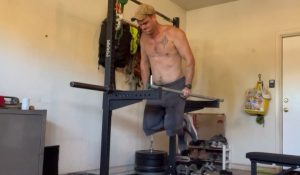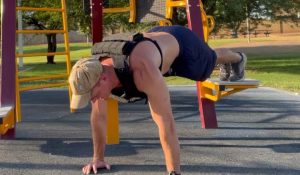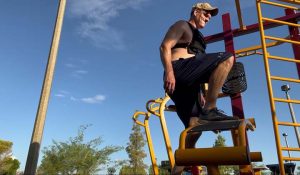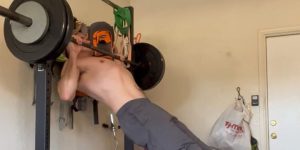As someone who is often recommending that people utilize pull-ups and chin-ups as a main back exercise, I’m often asked if inverted rows help with pull-ups. This is especially true among people who aren’t yet strong enough to do regular, bodyweight pull-ups on their own.
Ironically, this seems to be common advice: can’t do pull-ups? Just do inverted rows until you can! I would like to address this here, because I find that it’s generally bad advice.
If someone lacks the strength or muscle mass to do pull-ups, or if their body weight is too high, it’s extremely unlikely that just doing inverted rows will get them to their first pull-up. Similarly, doing lots of inverted rows is unlikely to improve the number of pull-ups a lifter can do.
The reason for this is that inverted rows and pull-ups are fundamentally different exercises.
Let’s draw a quick analogy
While inverted rows are fantastic exercise for packing on shoulder muscle with bodyweight, I don’t think they are particularly useful for improving pull-up strength. Let’s draw a quick analogy to illustrate the point:
If you take a young guy with weak legs, and you want to get his legs stronger, you would likely tell him to squat. Say he is a rank beginner, and he can currently squat 95 lbs for reps.
You may want him to get his squat up to 225 lbs and above. The problem, he’s not strong enough to squat 225.
Would you tell this guy to just do box step-ups until he can squat 225? Probably not. Box step-ups and squats are very different exercises! They are both compound leg exercises, and that’s basically where the similarities end.
The same is true for inverted rows and pull-ups.
Why inverted rows don’t help much with pull-ups
While inverted rows are great for building general muscle mass in the upper body, there are a number of reasons why they don’t tend to help much with improving pull-ups:
- They aren’t great at teaching the motor pattern of doing pull-ups. Many otherwise strong individuals can’t do pull-ups. Why? Because pull-ups are a very specific motor pattern. Learning to control the swing, pull from overhead, etc. requires specific practice on the exercise itself.
- They don’t stress the lats nearly as much as a de-loaded pull-up would. The main mover in the pull-up and chin-up is the latissimus dorsi, a very large, very strong muscle that spans all the way from the shoulder to the lower back. In a pull from overhead, this muscle is very elongated, whereas in an inverted row, the latissimus isn’t taken through a full range of motion. Inverted rows involve far more mid-trapezius, rhomboid, and rear delt than they do latissimus.
- They won’t help someone lose weight (if necessary). Many people who struggle with pull-ups can’t do them at least in part because they weigh too much. If the lifter doesn’t care about pull-up strength, this might be fine. However, if the lifter’s goal is specifically to improve pull-ups, then a little bit of weight loss often goes a long way.
The main reason is this: inverted rows and pull-ups are fundamentally different exercises. They are both compound back exercises, but that’s where the similarities end.
Lower the resistance, keep the movement pattern
In the “squat” analogy above, the lifter would be far better served by just squatting a weight less than 225, and incrementally increasing the weight on the bar until they reach their goal.
The same concept applies to pull-ups. Rather than switching to a completely different exercise (the inverted row), we need to do a similar exercise, but simply decrease the weight.
A better solution: Jackknife pull-ups
There are a number of better pulling exercises for getting our first pull-up or improving our pull-up performance: pull-ups with bands, negative pull-ups, assisted pull-up machines, and partner-assisted pull-ups. All of these are great options, and they work. But they have some drawbacks:
Most of us who are working out in our garages don’t have a dedicated assisted pull-up machine, and we often work out alone. Resistance bands are very helpful, but they tend to assist most during the bottom of the pull-up, where we need the least assistance.
There’s one exercise that stands above the rest for improving pull-ups: the jackknife pull-up. I believe that a far better substitute for helping with pull-ups is to simply do an exercise called the “jackknife pull-up” (see our full article on jackknife pull-ups here).
A jackknife pull-up is simply a pull-up where the lifter sets their feet straight out in front of them on a chair or bench, and sets the hand height of the bar or rings such that their body forms and “L” shape in the starting position:

Here, we’ve removed 40%-ish of our body weight from the equation, but we’re still doing a pull-up. Increasing the resistance can be accomplished easily by wearing a weighted vest or holding a weight plate across the thighs.
An astute observer will note that the angle of pull does change slightly as we ascend. This is true:
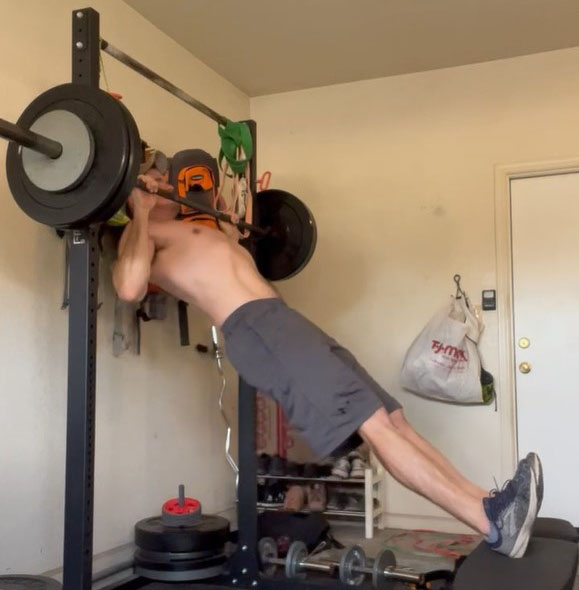
However, we’ve mimicked the movement pattern of a traditional pull-up much more closely than we would if we were simply hammering away at inverted rows.
How to use jackknife pull-us instead of inverted rows
A simple method of utilizing jackknife pull-ups instead of inverted rows would be to do a bi-weekly session focusing on pull-ups, splitting the work up between strength work and hypertrophy / assistance work like a strength athlete would:
Monday (Pull-ups, overhand grip)
- A: Pull-up negatives – 3 sets of 2-3 repetitions, 2-3 min rest between sets
- B: Jackknife pull-ups – 3 sets of 6-15, 2-3 reps in reserve (RIR) per set
Thursday (Chin-ups, underhand grip)
- A: Chin-up negatives – 3 sets of 2-3 repetitions, 2-3 min rest between sets
- B: Jackknife chin-ups – 3 sets of 6-15, leaving 2-3 RIR
If the lifter also needs to lose weight, they should combine it with a caloric deficit sufficient to promote weight loss, and an adequate amount of protein.
Using the program above, the lifter should be able to complete 1-2 pull-ups after a few weeks. At that point, they would just replace the negatives (Exercise A) with regular pull-up or chin-up sets of 1-3 repetitions.
Once they’re able to accomplish that, they should be able to switch to a dedicated pull-up program, such as the Armstrong program to continue to improve if they so desire.
Inverted rows are awesome – just not great for improving pull-ups
Don’t get me wrong, I love inverted rows. As someone who does pull-ups and chin-ups regularly, I think you’re really missing something special if you aren’t also doing inverted rows.
Many people mistakenly view inverted row variations as simply stepping stones in a pull-up progression, and this is a mistake. We’re better off treating it as a stand-alone exercise.
I think you should do inverted rows, even if you are strong. They are a great tool for building the upper body strength and upper back musculature. It just happens that inverted rows aren’t great for improving pull-ups.













